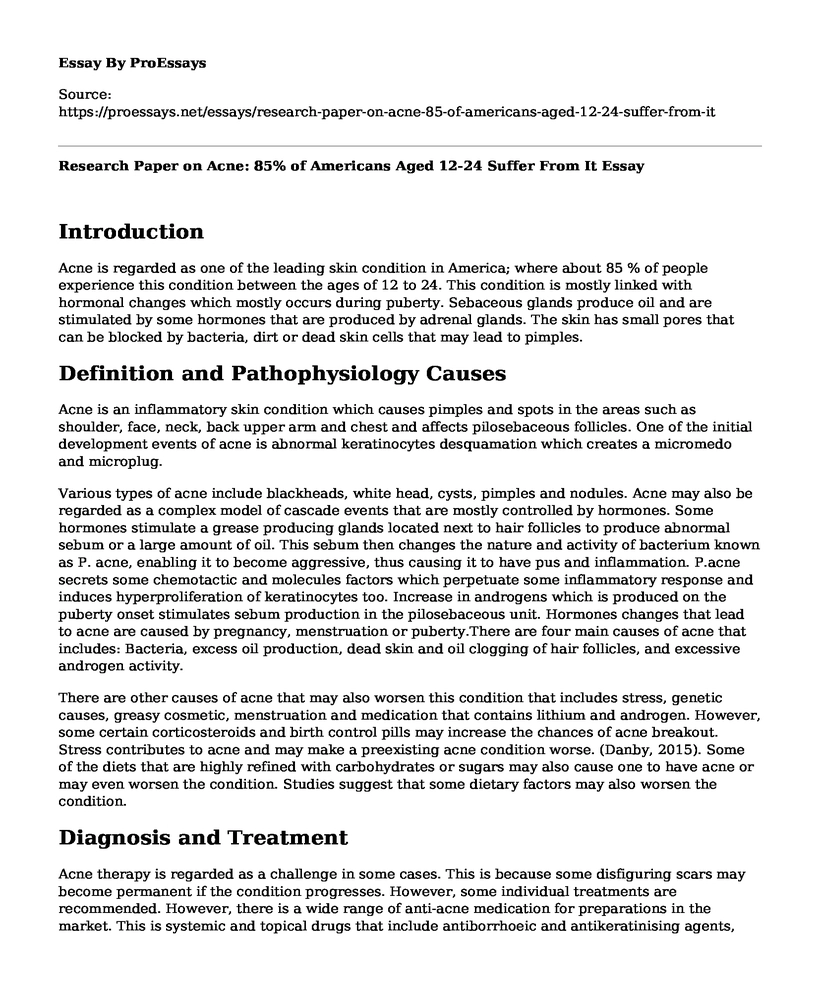Introduction
Acne is regarded as one of the leading skin condition in America; where about 85 % of people experience this condition between the ages of 12 to 24. This condition is mostly linked with hormonal changes which mostly occurs during puberty. Sebaceous glands produce oil and are stimulated by some hormones that are produced by adrenal glands. The skin has small pores that can be blocked by bacteria, dirt or dead skin cells that may lead to pimples.
Definition and Pathophysiology Causes
Acne is an inflammatory skin condition which causes pimples and spots in the areas such as shoulder, face, neck, back upper arm and chest and affects pilosebaceous follicles. One of the initial development events of acne is abnormal keratinocytes desquamation which creates a micromedo and microplug.
Various types of acne include blackheads, white head, cysts, pimples and nodules. Acne may also be regarded as a complex model of cascade events that are mostly controlled by hormones. Some hormones stimulate a grease producing glands located next to hair follicles to produce abnormal sebum or a large amount of oil. This sebum then changes the nature and activity of bacterium known as P. acne, enabling it to become aggressive, thus causing it to have pus and inflammation. P.acne secrets some chemotactic and molecules factors which perpetuate some inflammatory response and induces hyperproliferation of keratinocytes too. Increase in androgens which is produced on the puberty onset stimulates sebum production in the pilosebaceous unit. Hormones changes that lead to acne are caused by pregnancy, menstruation or puberty.There are four main causes of acne that includes: Bacteria, excess oil production, dead skin and oil clogging of hair follicles, and excessive androgen activity.
There are other causes of acne that may also worsen this condition that includes stress, genetic causes, greasy cosmetic, menstruation and medication that contains lithium and androgen. However, some certain corticosteroids and birth control pills may increase the chances of acne breakout. Stress contributes to acne and may make a preexisting acne condition worse. (Danby, 2015). Some of the diets that are highly refined with carbohydrates or sugars may also cause one to have acne or may even worsen the condition. Studies suggest that some dietary factors may also worsen the condition.
Diagnosis and Treatment
Acne therapy is regarded as a challenge in some cases. This is because some disfiguring scars may become permanent if the condition progresses. However, some individual treatments are recommended. However, there is a wide range of anti-acne medication for preparations in the market. This is systemic and topical drugs that include antiborrhoeic and antikeratinising agents, antibiotics, antibacterials, hormones, and retinoids.
Risk Factors
The risk factors associated with the acne condition that includes age: where teenagers are at high risk during puberty age as a result of hormonal changes. Hormonal changes are the other factors in teenagers, girls and women or even individual using some medication such as androgens, lithium or corticosteroids. Family history: where genetics plays a key role in acne. Oily or greasy substances: where if one's skin may come into contact with creamy or oily lotions. Pressure or skin friction: which may worsen the condition.
References
Danby, F. (2015). Acne. New York: Wiley Publishers.
Cite this page
Research Paper on Acne: 85% of Americans Aged 12-24 Suffer From It. (2023, Mar 28). Retrieved from https://proessays.net/essays/research-paper-on-acne-85-of-americans-aged-12-24-suffer-from-it
If you are the original author of this essay and no longer wish to have it published on the ProEssays website, please click below to request its removal:
- Background of Speech Delay in Toddlers - Research Paper Sample
- Impacts of Cancer on the Mental Health of School-Going and Cancer Patients
- Application for the School of Nursing
- Organ Transplant and Health Care Rights Essay
- Infectious Disease Trends - Research Paper
- How Ethics Relates to Vaccinations? - Informative Essay
- Free Essay Example on Improve Your Nursing Practice with Evidence-Based Practices







